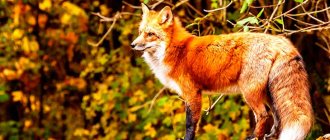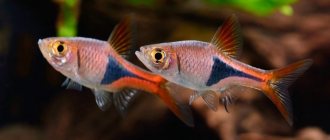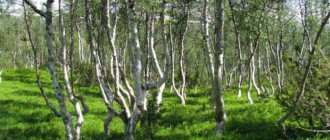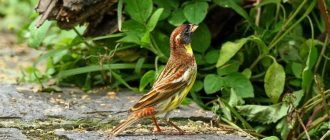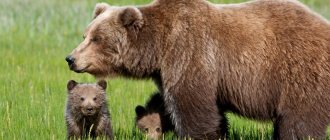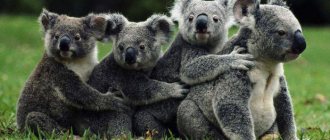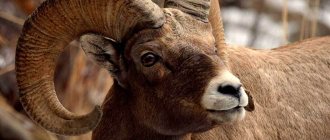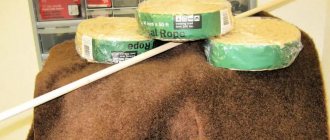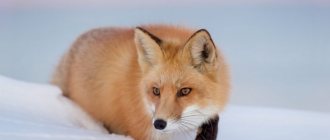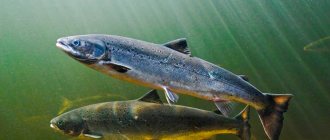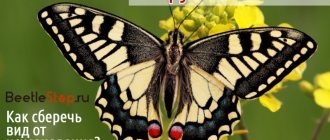Forests of this type contain a rich fauna. The largest populations of predators and ungulates, rodents and insects are found in forests where there is the least human intervention. Artiodactyls are represented by wild boars and deer, roe deer and moose. Among the predators, the forests are inhabited by large populations of martens and wolves, ferrets and foxes, weasels and stoats. You can also meet forest cats and lynxes, brown bears and badgers. Mostly forest predators are medium-sized animals, with the exception of bears. Populations of nutria, squirrels, muskrats, beavers and other rodents live here. At the lower level of the forest you can find hedgehogs, mice, rats, and shrews.
Character traits
The peculiarity of broad-leaved forests is that they can be divided into two distinct tiers. One of them is higher, the other is lower. These forests are shrubby, the existing grasses grow in three tiers, and the ground cover is represented by lichens and mosses.
Another characteristic feature is the light mode. In such forests, two light maxima are distinguished. The first is observed in the spring, when the trees are not yet covered with leaves. The second is in the fall, when the foliage thins. In summer, light penetration is minimal. The above-described regime explains the peculiarity of the grass cover.
The soil of deciduous forests is rich in organo-mineral compounds. They appear as a result of the decomposition of plant litter. Trees in broadleaf forests contain ash. There is especially a lot of it in the leaves - about five percent. Ash, in turn, is rich in calcium (twenty percent of the total volume). It also contains potassium (about two percent) and silicon (up to three percent).
Chilean cat
Another exotic deciduous forest animal is the Chilean cat, or kodkod. The animal lives in Chile and Argentina and is endemic to South America. This is the smallest representative of wild cats in the entire Western Hemisphere.
Kodkods also live in mixed and coniferous forests, mainly at an altitude of 2000-2500 meters. They are slightly larger than regular domestic cats. The body weight of the code-code usually does not exceed 3 kilograms, and its length is 80 centimeters. Chilean cats have large round eyes, round ears and a large tail that is almost half the length of the body. The entire body of the Kodkod is reddish-brown in color with dark spots on the back, sides and legs. There are dark stripes on the head and tail.
There are only two modern representatives of beavers: Canadian and ordinary, or river. The first inhabits most of North America, the second - Europe and Central Asia. Both species live in deciduous forests and are among the largest rodents on the planet.
The beaver is a powerful, stocky animal with a body length of up to 1.3 meters. It has short legs with membranes between its toes and a long paddle-shaped tail covered with horny scales. Its entire structure suggests that it spends a lot of time in water. Swim and dive beautifully, holding your breath for 10-15 minutes.
The main feature of these animals is their strong teeth, capable of chewing through a tree post overnight. With the help of such a tool, beavers build a home from lintels and rods. Their home is right on the water and consists of a hut and a dam around it. The beaver structure can reach several hundred meters.
Climate
The main condition for the development of a broad-leaved forest ecosystem is the complex interaction of climate, water, topography and soil characteristics. The climate is moderately warm with mild winters and long warm summers.
The average annual precipitation exceeds the level of evaporation, which reduces the degree of soil swamping. A characteristic feature is the light regime: the first light maximum is observed in the spring, when the trees are not yet covered with leaves; the second light maximum appears in autumn, with the period of leaf fall.
- Animals of Brazil
- Tarantula spider
- 34 facts about lions
- Lynx
- 37 facts about cheetahs
- Scolopendra
Wolf
The wolf is found throughout the Northern Hemisphere and is most widespread in Europe and Asia. The appearance of the animal depends on natural conditions. The inhabitants of taiga forests, characterized by a harsh climate, are usually larger than their counterparts. The length of an adult individual can reach 160 cm, the average weight ranges from 32 to 62 kg. Wolves are carnivorous; the main diet consists of roe deer, hares, wild boars and deer. In most cases, packs attack sick or old animals, for which wolves are called forest nurses. Life expectancy in the wild is 12-15 years.
Zone of broad-leaved forests of Russia
Russia's broadleaf forests occupy an area shaped like a triangle. Its peak is located at the foot of the Ural Mountains, and its base is at the western borders of the country. Arrays of broad-leaved trees are typical mainly for the European part: the south of Central Russia, the regions of the Middle Volga.
The richness of these massifs is determined by the diversity of tree and plant species growing here. Surprisingly, these forests are the most common in most regions of our country due to their adaptability to rapidly changing weather conditions and temperature conditions.
The zone of broad-leaved forests within Russia, and especially its European part, has been widely developed by man since ancient times and requires special protection from the anthropogenic impact of its flora and fauna.
Amur goral
Goral is a representative of the mountain forests of East Asia and the Far East. It lives on the Korean Peninsula, in the Primorsky and Khabarovsk territories of Russia, as well as in the northeastern regions of China.
This deciduous forest animal resembles a goat in appearance, covered with thick, warm fur. It is gray-brown in color with a dark longitudinal stripe on the back and a white patch on the neck. His head is decorated with two small backward-curved horns. Gorals live in small groups or alone. They are not fighters and in case of danger they begin to hiss and try to climb higher into the mountains.
Read more: Ultrasound of a cat during pregnancy
Trees of broadleaf forests
Forests of this type are characterized by a rich variety of tree species. The latter can be counted here about ten. Broad-leaved forests of the taiga, for example, are not so rich in this regard. The reason is that the conditions of the harsh taiga climate are not so conducive to the growth and development of flora. Many tree species that are demanding on soil composition and climate simply will not survive in unfavorable conditions.
In the southern part of the Tula region there is a famous forest area. It gives a great idea of what broadleaf forests can be like. The soil of this area is favorable for the growth of trees such as pedunculate oaks, small-leaved lindens, Norway maples and field maples, common ash trees, elms, elms, wild apple and pear trees. Oaks and ash trees are the tallest, followed by Norway maples, elms and lindens. The lowest are field maples, wild pears and apple trees. As a rule, the dominant position is occupied by oak, and the remaining trees act as satellites.
Let us consider in more detail the above representatives of dendroflora.
Oak
This is the main forest formation of broad-leaved forests in the European territory. English oak is one of the longest-growing and largest trees. It is also found in private areas in single plantings. Thanks to the ability of oak to tolerate pruning perfectly, it is possible to form beautiful tapeworms with spherical, obovate, tent-shaped crown shapes.
Elm
Smooth and rough species are found in forests of non-chernozem zones. These large trees make up the dominant layer of coniferous-deciduous and broad-leaved forests. Previously, they were widely used for landscaping, but recently this trend has decreased due to the spread of a disease such as Dutch elm disease.
Common ash
The plant reaches thirty to forty meters in height. This tree is characterized by a fairly straight trunk, light gray bark (darkens over time), and a loose openwork crown that lets in a lot of sunlight. Its root system is very branched and powerful, the inflorescences are dense and paniculate. A distinctive feature is its high demands on soil composition. Common ash is one of the main species for field protection. This is a warm and light-loving plant; it does not tolerate spring frosts well. Ash blossoms in May and the pollination process is carried out by the wind. Fruit ripening time is October-November. They fall either in winter or early spring.
Beech
Continuing the enumeration of what trees grow in a broad-leaved forest, one cannot fail to mention it. It reaches forty meters in height and one and a half meters in diameter. The beech bark is light gray, the leaves are elliptical. The territories of greatest distribution are Western Europe, the Caucasus, and Crimea. The main value of forest beech lies in its fruits. The nutritious nuts ripen between September and October. They consist of almost thirty percent of semi-drying fatty oil, and the same amount of nitrogenous substances. Valuable fruits are also rich in starch, sugars, acids (malic and citric), and tannins.
Interestingly, a poisonous alkaloid called fagin tends to decompose when nuts are fried. So it becomes absolutely safe for human health. A coffee substitute is produced from the fruits; when ground, they are added to regular flour when preparing flour products. Beech wood is a beautiful and durable decorative material.
Maple
Broad-leaved forests located in the European part of Russia, as well as in the Caucasus, are characterized as a favorable environment for the growth of Norway maples. These trees grow up to twenty meters in height. Their leaves are large, dark green, and five-lobed. The color of the bark is gray.
The shoots and leaves of this tree are widely used to treat various ailments. These gifts of nature contain large amounts of ascorbic acid, alkaloids, and tannins. Decoctions and infusions are used to treat wounds and inflammation. They also produce choleretic, diuretic, antiseptic and analgesic effects. Adherents of herbal medicine know very well which trees in the broad-leaved forest bring the greatest benefit. Thus, maple leaves and shoots are recommended for the effective treatment of jaundice, kidney stones, and to get rid of nausea and vomiting.
Linden
Linden is a typical representative of deciduous forests and grows up to 30 meters in height. The linden tree has a straight trunk and a compact oval crown. Thin young linden branches are easy to recognize even in winter, when there are no leaves on them. Oval buds, rounded at the top, are alternately located on the shoot. They are completely smooth and shiny, but they have one specific feature - each bud is covered with only two scales. You will not find such buds on our other trees.
Linden blooms much later than all our other trees, already in mid-summer. Its small, pale yellow, inconspicuous flowers have a wonderful aroma and are rich in nectar. Linden is one of the best honey plants.
Linden is a typically shade-tolerant species. In this it is second only to beech, spruce, fir, and hornbeam. Linden seedlings are considered especially shade-tolerant, growing successfully under the cover of broad grass, and even requiring shading in open areas. Moreover, it is shade-tolerant under the forest canopy and itself greatly shades the soil.
LiveInternetLiveInternet
—Tags
—Quote book
Masks against wrinkles around the eyes The skin around the eyes is thin and practically devoid of subcutaneous fat.
Increases and decreases for crochet (help for those who crochet) Country of Mothers → Increases and decreases.
Cheat sheet for knitters. CROCHET TECHNIQUES. Description and video. VERY CONVENIENT - COMPACTLY EXPOSED.
Original vest with knitting needles Original vest with knitting needles Show picture.
Femme fatales: they drove men crazy. https://pogovorim.mirtesen.ru/blog/43579371730/Rokov.
—Applications
- I am a photographer
Plugin for publishing photos in the user's diary. Minimum system requirements: Internet Explorer 6, Fire Fox 1.5, Opera 9.5, Safari 3.1.1 with JavaScript enabled. Maybe it will work - Download music from LiveInternet.ru
Simple download of songs at specified URLs - TorrNADO - torrent tracker for blogs
TorrNADO - torrent tracker for blogs - Postcards
Reborn catalog of postcards for all occasions - Battles
: Who has the better nail design? Who is more courageous? Who is more EMO? Whose friends have the most incredible fun? THIS WILL BE DECIDED BY THE BATTLE!!
-Music
—Categories
- (0)
- (0)
- Australia (2)
- Bathhouse (3)
- Badger fat (1)
- Birch (4)
- Beads (1)
- Potato dishes (4)
- Meat dishes (10)
- Vegetable and mushroom dishes (4)
- Fish dishes (2)
- Respiratory diseases, Ear, Nose and Throat (3)
- Sandwiches (3)
- Accounting (6)
- UK (1)
- Around the world (22)
- Volgograd region (8)
- All about coins (2)
- Main courses (3)
- Baking (26)
- Crochet (8)
- Knitting (38)
- Fortune telling, predictions (7)
- Valentine's Day (7)
- Valentine's Day February 14 (7)
- Children (5)
- Diet (7)
- House, dacha (26)
- Home first aid kit (22)
- Ancient Rus' (8)
- Jackets (7)
- Stomach (5)
- Animals, birds (19)
- Seafood snacks and their benefits (3)
- Locks (2)
- Salting fish (2)
- St. John's wort (2)
- Health (92)
- Getting rid of belly fat (5)
- Dough products (1)
- Icons (11)
- Stories about villages (11)
- Writers' stories (2)
- Historical events (27)
- History of Russia (14)
- History of the Urals (1)
- Yoga (3)
- Porridge (3)
- Books, stories, stories (4)
- Houseplants (9)
- Horse breeding (2)
- Canning, preparations, pickles (2)
- DIY cosmetics (31)
- Cooking recipes (11)
- Medicinal plants of swamps and ponds (2)
- Medicinal plants of the forest (12)
- Medicinal plants of the meadow (9)
- Desert Medicinal Plants (2)
- Medicinal plants of the steppe (3)
- Modeling (1)
- Linden (3)
- Manicure, pedicure, makeup (2)
- Honey (5)
- Medicine (20)
- Myths and legends of different countries (7)
- Myths of Rus' (2)
- Fashion (3)
- Prayers (6)
- Clothes, shoes (0)
- Weapons (1)
- Hunting (5)
- First courses (9)
- Pies (8)
- Pies (3)
- Pizza (2)
- Congratulations (3)
- Useful tips (7)
- Lenten recipes (2)
- Orthodox holidays (7)
- Holidays (4)
- Nature (8)
- Hairstyles and hair care (22)
- Birds (3)
- Travel (9)
- Beekeeping (3)
- Cancer (3)
- Religion (5)
- Eyelashes (2)
- Handicrafts (7)
- Rolls (1)
- Salads (15)
- Saints (17)
- Holy places, springs (4)
- DIY (1)
- Family (0)
- Cardiovascular diseases (7)
- Juices, drinks, teas (10)
- Pine (2)
- Sports (6)
- Poems (3)
- Joints (2)
- Cakes (3)
- Herbs (14)
- Exercises for eyes, eyebrows, face, neck (3)
- Spine exercises (9)
- Figure exercises (23)
- Drawing lessons (7)
- Eyelid skin care (5)
- Face, neck care (24)
- Learn to draw (8)
- Fitness (11)
- Photo (1)
- Fruits, vegetables, wild berries (9)
- I want to know everything (16)
- Temples, cathedrals, monasteries (8)
- Losing weight (25)
- Flowers (10)
- Cellulite (5)
- Chaga mushroom (2)
- Blouse sewing (2)
- Sewing, patterns (20)
- Humor (2)
—Links
-I'm a photographer
Animals
Mammals
Mammals of the broad-leaved forests of Western and Eastern Europe: wild boar, deer (red deer; in the forest zone outside Europe there are such subspecies as deer, wapiti, wapiti), elk, roe deer, bison, forest squirrel, chipmunk, beaver, bank vole, yellow-throated mouse, dormouse (dormouse, forest dormouse, garden and hazel dormouse), white hare, brown hare, common hedgehog, forest cat, lynx, fox, wolf, brown bear, badger, ermine, pine marten, weasel, European mink. Large animals have survived only in isolated areas that have not been destroyed by human economic activity (for example, in the Carpathian Mountains).
The fauna of monsoon broad-leaved forests in the Far East (Amur-Ussuri, Chinese, Korean) is especially rich, since species from the south penetrate there. Mammals include the Ussuri mole, Manchurian hare, sika deer, goral, Ussuri black bear (Himalayan or white-breasted bear), harza, raccoon dog, Amur tiger, Far Eastern leopard, Far Eastern forest cat.
An unusual animal of the broad-leaved forests of America is the skunk. Two wide white stripes run along the skunk's black coat from its head to its large fluffy tail. Another forest dweller typical of America is the raccoon, or striped raccoon.
Birds
Many birds make nests in the treetops. These are finches and swallows, rooks and harriers, larks and nightingales, crows and hawks, tits and sparrows. You can often find pigeons, bullfinches, woodpeckers, magpies, cuckoos, and orioles in forest areas. Among the large birds found in deciduous forests are pheasants and black grouse, as well as eagle owls and owls. Some species winter in forests, and some leave their homeland and fly to warmer regions in the fall and return in the spring.
Reptiles and amphibians
Broad-leaved forests are inhabited by snakes and vipers, snakes and copperheads. This is a fairly small list of snakes. You can find many lizards in the forests. These are green lizards, spindles, viviparous lizards. Near the reservoirs live tree frogs, fire-bellied toads, marsh turtles, sharp-faced and pond frogs, crested newts, and spotted salamanders.
Fish
It all depends on where in the world broad-leaved forests are located and what bodies of water are on their territory. Both salmon and carp fish species can be found in rivers, lakes and swamps. Catfish, pike, minnows and other species may also live.
Pine marten
The yellowbird, or pine marten, lives mainly in Europe. It has long and thick fur of a dark brown color. There is a light yellow spot on the animal’s chest, by which it can be easily distinguished from other martens. The animal is excellent at climbing trees, jumping 4 meters in length, easily maintaining balance. Pine martens live in hollows or abandoned nests of large birds, spending most of their lives in trees.
The forest needs help
Broadleaf forests really need human help. As paradoxical as it sounds, only it can reduce the destructive impact on nature.
To save forests, you need:
- plant seedlings in places where forest areas are interrupted for some reason,
- to ensure the protection of broad-leaved and other types of forests from encroachments by poachers and irresponsible entrepreneurs who mercilessly cut down large areas of this natural material,
- create all conditions so that buildings and cities are located at a certain distance from the forest.
All these conditions are not easy to comply with, since many of them are practically not controlled by the state. Industrial enterprises produce too large volumes of emissions into our atmosphere. Only forests can help clean the air. That is why their conservation is so important for the future of our planet.
Broad-leaved forests, like other forests, are the lungs of the Earth. Without forests, our planet could not exist in the form in which it functions and develops now.
All that is needed to maintain the ecological health of the planet is to protect forests. This is not so difficult, considering that only in our country do broad-leaved forests grow, the length of which has practically no analogues in the world. Since such wealth grows in one territory, it simply needs to be preserved.
Noble deer
A large mammal, which has many subspecies, lives in Europe, Asia, and North America. The weight of the animal ranges from 100 to 300 kg. The color of the deer changes depending on the time of year. Subspecies differ in the shape of their horns. The number of branches on them depends on the habitat, age and nutrition. The basis of the diet is herbs, grains and legumes. In winter, deer feed on pine needles, acorns, and lichens. The average life expectancy in the wild is 14 years. Natural enemies are bears, wolves, tigers, leopards, lynxes and wolverines.
Interesting facts about deciduous forests
- The main tree of the broad-leaved forest, the oak, can grow up to 500 years. At the same time, its crown increases by 1 m every year.
- In 1 day, a hundred-year-old oak can “drink” up to 600 liters of water. At the same time, the tree takes only 1/10 of all the substances necessary for life and growth from the soil. The rest is absorbed from the atmosphere.
- Logged oak forests are difficult to restore. Meanwhile, only 80 kg of recycled paper sent for recycling can save 1 tree.
- Another broad-leaved tree, linden, grows up to 400 years. But there are long-livers who have crossed the 1000-year mark.
- The origin of many geographical names among the Slavs is associated with linden: Lipki, Lipovets, Lipetsk, Lipno, Podlipki.
- Maple is one of the fastest growing trees. This broad-leaved tree can grow 2 m in just a year. Maples are loved by bees because they are good honey plants. Therefore, they are often planted next to apiaries.
- Broad-leaved forests are not the most extensive in Russia. The Siberian taiga holds the title of the largest forest not only in the country, but also in the world. But it is believed that it was precisely the zone of growth of mixed and broad-leaved forests that was the territory on which the traditions, customs and culture of the Russian people were formed.
Video
Fox
The common fox is the most common inhabitant of the temperate zone. It is distributed throughout Europe, most of North America and Asia. The animal lives even on the northern outskirts of Africa. It inhabits tundra, desert and semi-desert, and, of course, deciduous and mixed forests.
The fox is a predator, but can also eat plant foods. It hunts small mammals, rodents, birds, snakes, and eats eggs and young animals. Foxes living near large rivers often fish. Thus, animals living in Canada and northeast Eurasia completely switch to a salmon diet during the spawning season.
Foxes live in holes that they dig themselves, or settle in the abandoned dwellings of other forest inhabitants. They belong to the canine family and have many habits that are characteristic of their “brothers”.
Chipmunk
Chipmunks live in dense forests of Eurasia and North America, preferring forest edges and windbreaks. The body size without a tail is 18-25 cm, weight - 50-150 g. Animals lead an active life during the day, and at night they sleep. Chipmunks live alone, each individual builds a cozy shelter for itself. Near the dwelling there are small storerooms with supplies. The food source is seeds, berries, mushrooms, nuts and herbs. Under natural conditions, chipmunks live no more than three years. The animal has many natural enemies: bear, sable, squirrel and fox. Birds of prey and snakes also pose a danger.
Badger
The predator from the mustelid family is found almost throughout the entire territory of Eurasia, with the exception of Scandinavia. The body length of the animal varies between 60-90 cm, and the average weight is 7-13 kg. Badgers live in high, dry areas, near ponds or swamps. They make deep burrows with nesting sites on the slopes of banks or ravines. The food source is insects, small animals, as well as seeds, mushrooms, fruits and berries. By winter, the badger gains fat and goes into hibernation. Life expectancy in nature is 10-12 years. Natural enemies are bears, wolves and lynxes.
Brown hare
Hares live in the forests of Europe, Central Asia and Western Siberia. Rusaks were artificially settled in North America, Australia, and New Zealand. The body length of an adult is 57-68 cm, weight - 4-6 kg. In summer, the animal's fur has a reddish-brown tint, and becomes lighter in winter. The tips of the ears remain black throughout the year. A hare's hole is a depression under the roots of trees. In summer, hares eat grasses, grains and legumes. In winter, they eat willow branches, tree bark, and seeds. It is not easy to catch the animal; it reaches a speed of 60 km/h. The average life expectancy of brown hares in nature is 6-7 years. The greatest danger is represented by foxes and wolves.
Ussurian tiger
A rare animal listed in the Red Book of Russia, which lives in the south of the Far East. The Ussuri tiger is the largest subspecies of the tiger. The body length with tail is 270-380 cm, weight can reach 300 kg. Despite their impressive size, tigers, like all cats, move almost silently. The climate of the Far East is quite harsh, so the animal has thick fur. The main coat color is red, with the exception of the belly and chest. Its entire surface is covered with black stripes. Tigers live alone and mark their territory by urinating on trees. The predator most often hunts boars, badgers, wolves and lynxes. Tigers skillfully catch fish and do not neglect small animals - frogs, mice, birds, as well as plants and fruits. In one meal, an animal can eat 30 kg of meat. In the wild, tigers live for about 15 years and have no natural enemies.
